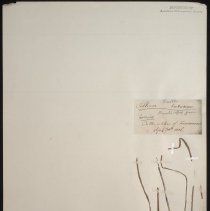Object Record
Images

Metadata
Catalog Number |
PH-LC 7 |
Object Name |
Specimen |
Title |
Allium geyeri |
Other Name |
Textile Onion |
Collector |
Meriwether Lewis & William Clark |
Date |
1806 |
Description |
The identification of this specimen is problematic. The only Lewis and Clark specimen of Allium that Pursh (1813: 223) cites is under Allium angulosum L. (Sp. Pl.: 300. 1753) with the location "On the banks of the Missouri." Based on the description given by Pursh, the specimen in question may have been a collection of A. textile A. Nelson & J. F. Macbr. (Bot. Gaz. 56: 470. 1913). Meehan (1898: 42) did not obtain a name from Robinson and Greenman for the extant Lewis and Clark specimen, but suggests the plant might be A. reticulatum Nutt. ex Don (in Mem. Wern. Soc. 6: 36. 1827, non J. & C. Presl, 1819) an illegitimate name that is now in synonymy under A. textile. The Academy specimen is labeled "On the waters of the Kooskooskie / April. 30th 1806." Unfortunately, on 30 Apr, Lewis and Clark were at the mouth of the Walla Walla River in Washington (Coues, 1898: 312) and not along the Clearwater River, the modern name for the Kooskooske, in Idaho. However, on 30 May 1806 when Lewis provides a description of A. tolmiei Baker ex S. Watson var. platyphyllum (Tidestr.) Ownbey (in Res. Stud. St. Coll. Wash. 18: 28. 1950) or perhaps A. douglasii Hook. var. columbianum Ownbey & Mingrone (in Univ. Wash. Publ. Biol. 17(6): 747. 1969), he alludes to another species of Allium that grows along "the borders of the river" (Moulton, 1991: 311). Moulton (1991: 312) suggests this is A. geyeri, and given the date, the plant should have been in flower and well worth collecting. It is possible, therefore, that the date given on the label is a lapse for 30 May. At the time, Lewis and Clark were camped along the east bank of the Clearwater River northwest of Kamiah in what is now Idaho Co., Idaho, at what has become known as "Camp Chopunnish." The party was routinely eating the bulbs of A. geyeri (Moulton, 1991: 264, 266). As the extant specimen consists only of leaves, it is difficult to identify. Given the number of leaves present on the specimen, and their length, we suggest the location is correctly given and the specimen is Allium geyeri. The suggestion that the plant might be A. textile from Washington is not supportable as this is outside the known distribution of the species whose range extends only as far westward as south-central Idaho. One additional fact is important here. Although the plant was not described, Pursh gives it a name, "Allium kuskuskiense," on the specimen label. This would seem to imply he had more bountiful material than what we have found for it is doubtful he would have established a new species strictly on sterile material. That he did not publish the name also implies what he had before him was still of rather poor quality. In addition, the specimen is probably not what Pursh had in mind when he described A. angulosum, meaning that there might be specimens of another Allium yet to be found. Finally, the reference to white flowers given by Pursh under A. angulosum is difficult to interpret. If indeed he had specimens of the predominately white-flowered A. textile from along the upper Missouri in Montana then the combination of location and flower color is correct. However, the flowers of A. angulosum, a well-known European species, are purplish. If the location of the extant sterile specimen is correct, then A. geyeri, a predominately pink-flowered species, may well be what he had in his possession and the use of A. angulosum is better understood. When all is said and done we suspect that initially there were two collections of Allium, one from the upper Missouri River that most likely was A. textile, and a second from Idaho, the A. geyeri specimen that is still extant. (The Lewis & Clark Herbarium Digital Imagery Study Set, ANSP, 2002) On deposit at the Academy of Natural Sciences, Philadelphia |
Label |
Starting in 1803, Merriwether Lewis (APS 1803) and William Clark embarked on a 3 year expedition along the Missouri and Columbia rivers to the Pacific Coast. They collected hundreds of plant specimens to carry back to the East Coast. They pressed these plants, attached them to sheets of paper and wrapped them in oilskin to survive the long journey intact. Allium geyeri, commonly called the Geyer's onion, is a flowering plant found along the Western coast and Rocky Mountains regions of the United States. In the spring of 1806, when Lewis and Clark collected this particular specimen along the Clearwater River (historically called Kooskooskie) near present day Kamiah, Idaho, the expedition crew regularly ate the bulbs of the plant, which provide a subtle onion flavor. |
Credit line |
American Philosophical Society. Gift of Thomas Jefferson, 1805 - 1806. |
Search Terms |
19th century botany Clark herbarium Lewis nineteenth century plant specimen |
Collection |
The Lewis & Clark Herbarium |
